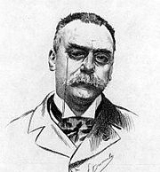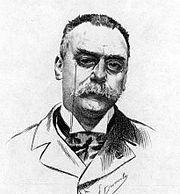
Eugène Grasset
Encyclopedia

Belle Époque
The Belle Époque or La Belle Époque was a period in European social history that began during the late 19th century and lasted until World War I. Occurring during the era of the French Third Republic and the German Empire, it was a period characterised by optimism and new technological and medical...
. He is considered a pioneer in Art Nouveau
Art Nouveau
Art Nouveau is an international philosophy and style of art, architecture and applied art—especially the decorative arts—that were most popular during 1890–1910. The name "Art Nouveau" is French for "new art"...
design.
Biography
Grasset was born in Lausanne, Switzerland, his birth year is sometimes stated as 1841. He was raised in an artistic environment as the son of a cabinet designer/maker and sculptor. He studied drawing under Francois-Louis David Bocion (1828-1890) and in 1861 went to ZurichZürich
Zurich is the largest city in Switzerland and the capital of the canton of Zurich. It is located in central Switzerland at the northwestern tip of Lake Zurich...
to study architecture. After completing his education, he visited Egypt
Egypt
Egypt , officially the Arab Republic of Egypt, Arabic: , is a country mainly in North Africa, with the Sinai Peninsula forming a land bridge in Southwest Asia. Egypt is thus a transcontinental country, and a major power in Africa, the Mediterranean Basin, the Middle East and the Muslim world...
, an experience that would later be reflected in a number of his poster designs. He became an admirer of Japanese art
Japanese art
Japanese art covers a wide range of art styles and media, including ancient pottery, sculpture in wood and bronze, ink painting on silk and paper and more recently manga, cartoon, along with a myriad of other types of works of art...
which too influenced some of his creative designs. Between 1869 and 1870, Grasset worked as a painter and sculptor in Lausanne but moved to Paris in 1871 where he designed furniture fabrics and tapestries as well as ceramics and jewelry. His fine art decorative pieces were crafted from ivory, gold and other precious materials in unique combinations and his creations are considered a cornerstone of Art Nouveau motifs and patterns.
In 1877 Eugène Grasset turned to graphic design, producing income-generating products such as postcards and eventually postage stamps for both France and Switzerland. However, it was poster
Poster
A poster is any piece of printed paper designed to be attached to a wall or vertical surface. Typically posters include both textual and graphic elements, although a poster may be either wholly graphical or wholly text. Posters are designed to be both eye-catching and informative. Posters may be...
art that quickly became his forté. Some of his works became part of the Maîtres de l'Affiche
Maîtres de l'Affiche
Maîtres de l'Affiche refers to 256 color lithographic plates used to create a very significant art publication during the Belle Époque in Paris, France...
including his lithograph, "Jeanne d'Arc Sarah Bernhardt." In 1890, he designed the "Semeuse who spreads seeds of dandelion" logo used by the dictionary publishers, Éditions Larousse
Éditions Larousse
Éditions Larousse is a French publishing house specialising in reference works such as dictionaries. It was founded by Pierre Larousse and its best-known work is the Petit Larousse.It was acquired by Vivendi Universal in 1998...
. And the logo also gave inspiration to the image of the Yogyakarta Principles
Yogyakarta Principles
The Yogyakarta Principles on the Application of International Human Rights Law in relation to Sexual Orientation and Gender Identity is a set of principles relating to sexual orientation and gender identity, intended to apply international human rights law standards to address the abuse of the...
With the growing popularity of French posters in the United States, Grasset was soon contacted by several American companies. In the 1880s, he did his first American commission and more success led to his cover design for the 1892 Christmas issue of Harper's Magazine
Harper's Magazine
Harper's Magazine is a monthly magazine of literature, politics, culture, finance, and the arts, with a generally left-wing perspective. It is the second-oldest continuously published monthly magazine in the U.S. . The current editor is Ellen Rosenbush, who replaced Roger Hodge in January 2010...
. In 1894 Grasset created "The Wooly Horse" and "The Sun of Austerlitz" for The Century Magazine
The Century Magazine
The Century Magazine was first published in the United States in 1881 by The Century Company of New York City as a successor to Scribner's Monthly Magazine...
to help advertise their serialized story on the life of Napoleon Bonaparte. The "Wooly Horse" image proved so popular that Louis Comfort Tiffany
Louis Comfort Tiffany
Louis Comfort Tiffany was an American artist and designer who worked in the decorative arts and is best known for his work in stained glass. He is the American artist most associated with the Art Nouveau and Aesthetic movements...
recreated it in stained glass. Grasset's work for U.S. institutions helped pave the way for Art Nouveau to dominate American art.
At the end of the 19th century, Grasset was hired to teach design at École Guérin (from 1890 to 1903), at École d’Art graphique from Madame street (from 1903 to 1904), at Académie de la Grande Chaumière
Académie de la Grande Chaumière
The Académie de la Grande Chaumière is an art school in the VIe arrondissement of Paris, France. The school was founded in 1902 by the Swiss Martha Stettler , who refused to teach the strict academic rules of painting of the École des Beaux-Arts. It opened the way to the "Art Indépendant"...
(from 1904 to 1913) and at École Estienne
École Estienne
L’école Estienne is the traditional name of the Graduate School of Arts and Printing Industry. It is located at 18, Boulevard Auguste-Blanqui in the 13th arrondissement of Paris, not far from the Butte-aux-Cailles.-History:...
in Paris. Among his students were:
Paul Berthon,
Georges Bourgeot,
Paul Follot,
Marcelle Gaudin,
Augusto Giacometti
Augusto Giacometti
Augusto Giacometti was a Swiss painter from Stampa, Graubünden, cousin of Giovanni Giacometti who was the father of Alberto, Diego and Bruno Giacometti....
,
Arsène Herbinier,
Anna Martin
Anna Martin
Anna Martin may refer to*Anna Maxwell Martin , English actress*Anna Mebus Martin , American businesswoman and bank president...
,
Mathurin Méheut
Mathurin Méheut
Mathurin Méheut was a French painter, ceramicist, engraver, and etcher best known for his depictions of Breton scenes, the sea, and nature....
,
Juliette Milési,
Otto Ernst Schmidt,
Auguste Silice,
Maurice Pillard Verneuil,
Aline Poidevin,
Pierre Selmersheim,
Tony Selmersheim,
Camille Gabriel Schlumberger,
Eliseu Visconti,
and Philippe Wolfers
At the Universal Exhibition of 1900
Exposition Universelle (1900)
The Exposition Universelle of 1900 was a world's fair held in Paris, France, from April 15 to November 12, 1900, to celebrate the achievements of the past century and to accelerate development into the next...
in Paris, the G. Peignot et Fils typefoundry, introduced the "Grasset" typeface
Typeface
In typography, a typeface is the artistic representation or interpretation of characters; it is the way the type looks. Each type is designed and there are thousands of different typefaces in existence, with new ones being developed constantly....
, an Italic design Eugène Grasset created in 1898 for use on some of his posters.
Eugène Grasset died in 1917 in Sceaux
Sceaux, Hauts-de-Seine
Sceaux is a commune in the southern suburbs of Paris, France. It is located from the center of Paris.-Wealth:Sceaux is famous for the Château of Sceaux, set in its large park , designed by André Le Nôtre, measuring...
in the Hauts-de-Seine
Hauts-de-Seine
Hauts-de-Seine is designated number 92 of the 101 départements in France. It is part of the Île-de-France region, and covers the western inner suburbs of Paris...
département southwest of Paris.
Exhibitions
- Musée cantonal des Beaux-Arts, Lausanne, 2011 http://www.musees.vd.ch/fr/musee-des-beaux-arts/
See also
- PosterPosterA poster is any piece of printed paper designed to be attached to a wall or vertical surface. Typically posters include both textual and graphic elements, although a poster may be either wholly graphical or wholly text. Posters are designed to be both eye-catching and informative. Posters may be...

